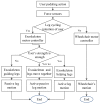Design and Feasibility Study of a Leg-exoskeleton Assistive Wheelchair Robot with Tests on Gluteus Medius Muscles
- PMID: 30696120
- PMCID: PMC6387381
- DOI: 10.3390/s19030548
Design and Feasibility Study of a Leg-exoskeleton Assistive Wheelchair Robot with Tests on Gluteus Medius Muscles
Abstract
The muscles of the lower limbs directly influence leg motion, therefore, lower limb muscle exercise is important for persons living with lower limb disabilities. This paper presents a medical assistive robot with leg exoskeletons for locomotion and leg muscle exercises. It also presents a novel pedal-cycling actuation method with a crank-rocker mechanism. The mechanism is driven by a single motor with a mechanical structure that ensures user safety. A control system is designed based on a master-slave control with sensor fusion method. Here, the intended motion of the user is detected by pedal-based force sensors and is then used in combination with joystick movements as control signals for leg-exoskeleton and wheelchair motions. Experimental data is presented and then analyzed to determine robotic motion characteristics as well as the assistance efficiency with attached electromyogram (EMG) sensors. A typical muscle EMG signal analysis shows that the exercise efficiency for EMG activated amplitudes of the gluteus medius muscles approximates a walking at speed of 3 m/s when cycling at different speeds (i.e., from 16 to 80 r/min) in a wheelchair. As such, the present wheelchair robot is a good candidate for enabling effective gluteus medius muscle exercises for persons living with gluteus medius muscle disabilities.
Keywords: EMG signal; assistive robots; master-slave control; muscle exercises; pedal-actuated wheelchair.
Conflict of interest statement
The authors declare no conflict of interest.
Figures














References
-
- Park B.S., Noh J.W., Kim M.Y., Lee L.K., Yang S.M., Lee W.D., Shin Y.S., Kim J.H., Lee J.U., Kwak T.Y., et al. The effects of aquatic trunk exercise on gait and muscle activity in stroke patients: A randomized controlled pilot study. J. Phys. Ther. Sci. 2015;27:3549–3553. doi: 10.1589/jpts.27.3549. - DOI - PMC - PubMed
-
- Population Ageing and Sustainable Development. [(accessed on 09 November 2018)]; Available online: http://www.un.org/en/development/ desa/population/publications/pdf/popfa....
-
- Kim J., Oh S.I., Cho H., Kim H.S., Chon J., Lee W.J., Shin J.H., Ahn J.Y., Kim T., Han J.S., et al. Gait patterns of chronic ambulatory hemiplegic elderly compared with normal age-matched elderly. Int. J. Precis. Eng. Manuf. 2015;16:385–392. doi: 10.1007/s12541-015-0051-z. - DOI
-
- Deborah C., Samuel V., Sunaina A. evolution of robotics in medical surgeries and health care systems: A review. Int. J. Appl. Eng. Res. 2016;11:11277–11298.
MeSH terms
Grants and funding
LinkOut - more resources
Full Text Sources
Research Materials

